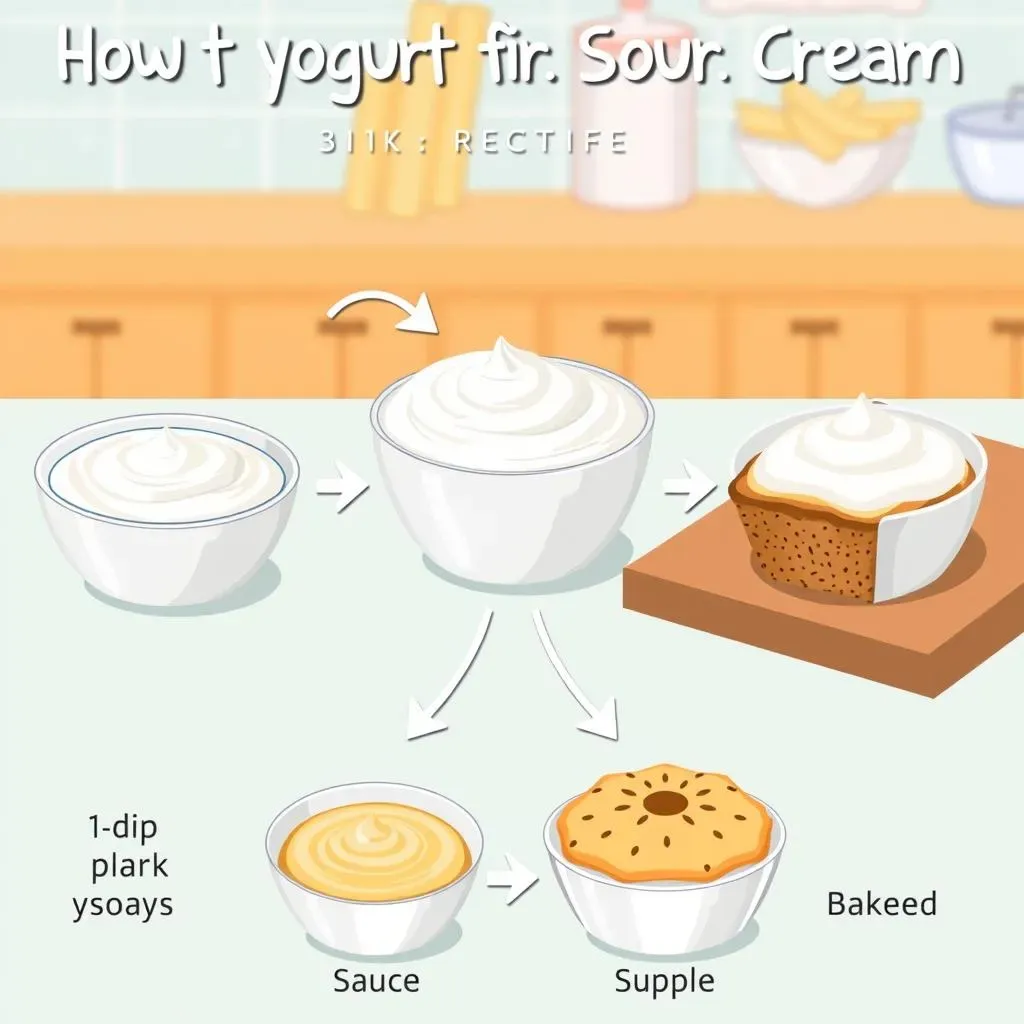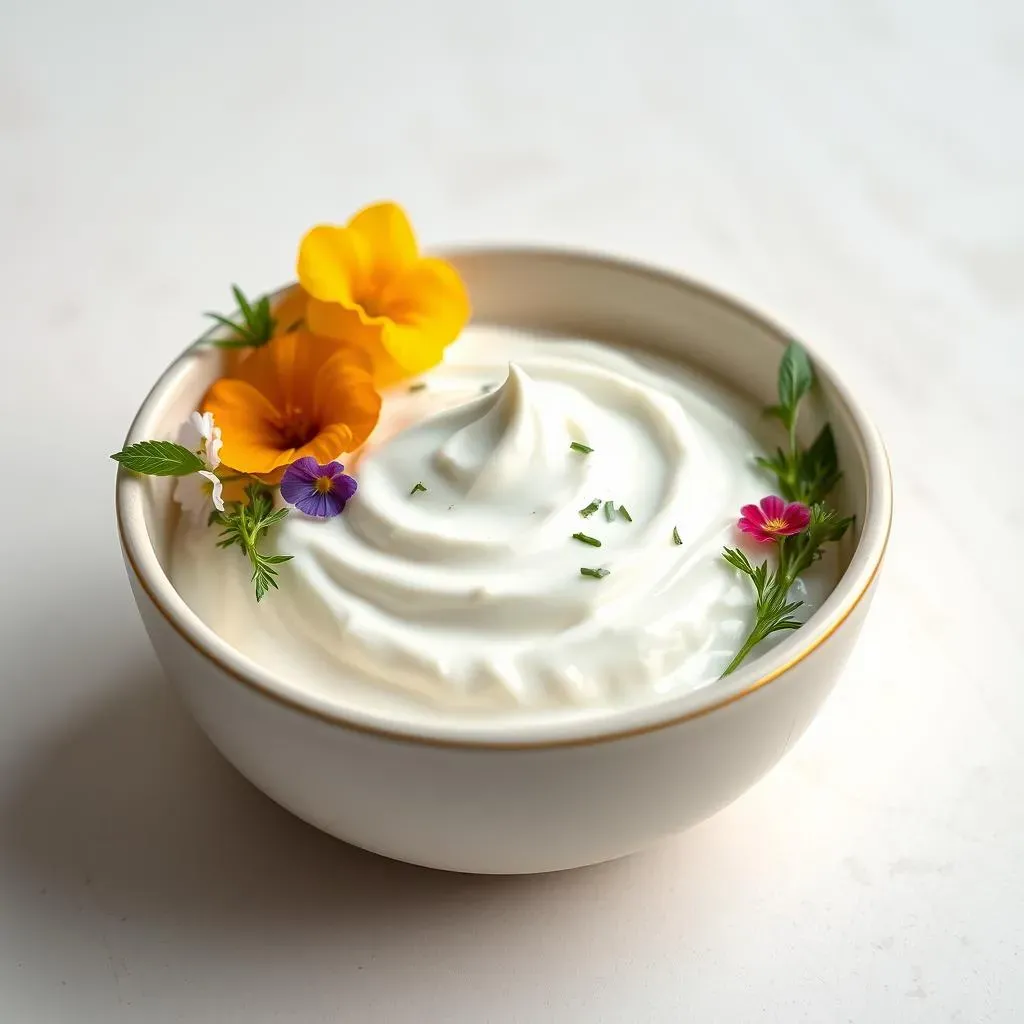Table of Contents
Ever found yourself staring into the fridge, recipe in hand, only to realize you're out of sour cream? It's a kitchen crisis we've all faced. But what if I told you the answer was probably already chilling right next to it? That's right, I'm talking about yogurt! Using yogurt instead of sour cream isn't just a matter of convenience, it's a smart swap that can lighten up your dishes, boost the protein, and even add a tangy twist. This article will show you the ropes on substituting yogurt for sour cream, helping you navigate the world of creamy alternatives. We'll cover why this swap is a good idea, which yogurts work best, how to make the switch in your recipes, and the common slip-ups to avoid. Get ready to unlock the potential of yogurt and say goodbye to sour cream emergencies!
Why Substitute Sour Cream with Yogurt?

Why Substitute Sour Cream with Yogurt?
Healthier Choice, Happier You
Let's be honest, sour cream is delicious. But it's also packed with fat and calories. If you're looking to lighten things up, substituting yogurt for sour cream is a no-brainer. Yogurt, especially Greek yogurt, is lower in fat and calories while offering a good dose of protein. It's like getting a nutritional upgrade without sacrificing that creamy texture we love. Plus, it's easier on your digestive system for some people. It is a win-win situation in my book.
The Tangy Twist
Sour cream has that signature tang, right? Well, guess what? Yogurt has it too. It might be a slightly different kind of tang, but it's a welcome addition, especially in dishes that need a little zing. Think about it: dips, sauces, even baked goods. That yogurt tang can elevate the flavor profile, adding a layer of complexity that's just delightful. It's not just a replacement; it's an enhancement.
I once made a batch of enchiladas and was out of sour cream. I used plain Greek yogurt, and wow, the tanginess made them even better! My family actually preferred it.
Versatility is Key
Another great reason to make the switch is the sheer versatility of yogurt. You can use it in so many ways. From dolloping it on tacos to mixing it into smoothies, yogurt is a kitchen workhorse. It plays well with both sweet and savory dishes, making it a super handy ingredient to have around. I always have a tub of Greek yogurt in my fridge, just in case I need a quick substitute or a healthy snack.
Benefit | Sour Cream | Yogurt (especially Greek) |
|---|---|---|
Fat Content | High | Lower |
Calorie Count | High | Lower |
Protein | Low | High |
Tang | Present | Present |
Versatility | Limited | High |
Best Types of Yogurt for Substituting Sour Cream

Best Types of Yogurt for Substituting Sour Cream
Greek Yogurt: The Champion
When it comes to substituting yogurt for sour cream, Greek yogurt is the undisputed champion. It's thick, creamy, and has that tangy flavor we're looking for. The straining process removes a lot of the whey, leaving behind a yogurt that's much closer in consistency to sour cream. You can use it in almost any recipe that calls for sour cream, and you'll hardly notice the difference. Plus, the protein punch is a great bonus. I always recommend starting with Greek yogurt if you're new to this substitution game.
I remember one time I tried using regular yogurt instead of Greek in a dip, it was a watery disaster. Lesson learned: Greek yogurt is the way to go!
Regular Yogurt: Proceed with Caution
Now, regular yogurt can work in a pinch, but it's not always a direct swap. It tends to be thinner and has a higher water content, so it might make your recipes a bit runny. If you do use it, you might need to adjust the other liquids in your recipe. For example, if a recipe calls for a cup of sour cream and you're using regular yogurt, reduce other liquids like milk or broth by a couple of tablespoons. It's also a good idea to use full-fat regular yogurt if you want to get closer to the richness of sour cream. But honestly, if you have a choice, stick with Greek yogurt.
I have use regular yogurt in cakes and it turned out very different, the flavor was not as rich, and the texture was a bit off.
Yogurt Type | Consistency | Tang Level | Best Uses |
|---|---|---|---|
Greek Yogurt | Thick and Creamy | High | Dips, sauces, baking, toppings |
Regular Yogurt | Thinner, more liquid | Medium | Smoothies, some baking (with adjustments) |
Full-Fat Yogurt | Richer, creamier | Medium to High | Baking, sauces (with adjustments) |
How to Substitute Yogurt for Sour Cream in Recipes

How to Substitute Yogurt for Sour Cream in Recipes
The 1:1 Swap
Okay, so you've got your yogurt, now what? The good news is that most of the time, substituting yogurt for sour cream is a simple 1:1 swap. If your recipe calls for a cup of sour cream, use a cup of Greek yogurt. Easy peasy, right? This works especially well in dips, sauces, and toppings. I've used this method countless times, and it's rarely steered me wrong. Just remember to start with plain yogurt, not the flavored kind. Unless you're making something really experimental, vanilla yogurt in a chili might not be the best idea.
I once tried to make a strawberry dip with vanilla yogurt and it was just too sweet, it overpowered the flavor of the strawberries. Lesson learned, always go for plain!
Adjusting for Baking
Baking is where things can get a little trickier. Because regular yogurt has more liquid than sour cream or Greek yogurt, you might need to make some adjustments. If you're using regular yogurt, reduce the other liquids in your recipe by a tablespoon or two. This will help prevent your baked goods from becoming too soggy. Also, consider using full-fat yogurt for a richer taste and texture. If you're using Greek yogurt, you're usually good to go with the 1:1 swap, but keep an eye on the batter. If it looks too thick, you might need to add a splash of milk or water.
I've learned from experience that small adjustments can make a big difference in baking. It is like a science experiment, but a delicious one.
Recipe Type | Yogurt Type | Swap Ratio | Adjustments |
|---|---|---|---|
Dips & Sauces | Greek Yogurt | 1:1 | None needed |
Baking | Greek Yogurt | 1:1 | Add a splash of liquid if needed |
Baking | Regular Yogurt | 1:1 | Reduce other liquids by 1-2 tablespoons |
Toppings | Greek Yogurt | 1:1 | None needed |
Common Mistakes When Substituting Yogurt for Sour Cream

Common Mistakes When Substituting Yogurt for Sour Cream
Using the Wrong Type of Yogurt
Alright, let's talk about some common slip-ups. One of the biggest mistakes people make is not using the right kind of yogurt. I've seen it all, from using sweetened yogurt in savory dishes to grabbing the thinnest yogurt they can find. Remember, Greek yogurt is your best friend here. It has that thick, creamy consistency that closely mimics sour cream. If you use regular yogurt, your dish might end up watery, and if you use flavored yogurt, well, your chili might taste like a dessert. So, before you start cooking, double-check that you have plain, full-fat Greek yogurt if you want the best results. It's a small step, but it makes a world of difference.
Ignoring the Tang Factor
Another mistake people make is not considering the tanginess of yogurt. While it's similar to sour cream, it's not an exact match. Sometimes, yogurt can be a bit tangier than sour cream, which might not work well in all recipes. If you're making a dish where a subtle flavor is key, you might want to start with a bit less yogurt and taste as you go. You can also add a pinch of sugar or a tiny bit of baking soda to balance out the acidity. I learned this lesson the hard way when my first attempt at a creamy pasta sauce turned out way too tangy. Now I always taste and adjust as I go.
Mistake | Consequence | Solution |
|---|---|---|
Using regular yogurt | Watery consistency | Use Greek yogurt |
Using flavored yogurt | Unexpected flavors | Use plain yogurt |
Ignoring the tang | Overly tangy taste | Taste and adjust, add a pinch of sugar |
Over-Mixing in Baking
When it comes to baking, over-mixing can be a real problem, especially when you're using yogurt. Over-mixing can lead to a tough or dense final product, because it develops the gluten in the flour too much. When you add yogurt to your batter, mix just until everything is combined. Don't go crazy with the whisk or mixer. A gentle hand is key to a light and fluffy baked good. I once made a batch of muffins that were as hard as rocks, all because I over-mixed the batter after adding the yogurt. Now I'm all about that gentle fold.
Not Adjusting for Liquid
Finally, people often forget to adjust the liquid content in their recipes. Remember, regular yogurt has more liquid than sour cream or Greek yogurt. If you're not careful, your sauces might end up too thin and your baked goods might be soggy. Always reduce the other liquids by a tablespoon or two if you're using regular yogurt. And if you're using Greek yogurt, you might need to add a splash of liquid if your batter looks too thick. It's all about finding that perfect balance. I've had my share of runny dips and soggy cakes, but now I'm a pro at adjusting liquids.
- Always use plain yogurt.
- Start with Greek yogurt for best results.
- Taste and adjust for tanginess.
- Mix gently when baking.
- Adjust liquid content to avoid soggy results.